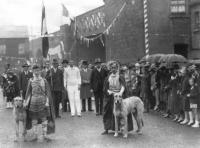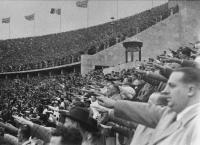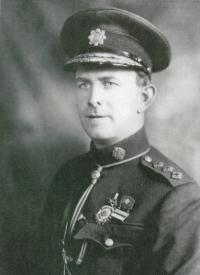‘A first-class split’:political conflict in Irish athletics, 1924–40
Published in 20th-century / Contemporary History, Features, Issue 4 (July/August 2012), Volume 20
The parade from the 1928 Tailteann games at Croke Park. NACA president J.J. Keane is in the centre of the picture (to the left of the right-hand wolfhound-handler). When in 1924 he agreed to drop the NACA’s rule (inherited from the GAA) excluding British servicemen and police from membership and accepted a compromise on Sunday competitions, the Northern clubs accepted unity—but not for long. (Cyril White)

The Berlin Olympics, 1936—why were Irish competitors not there? (AKG Photo)
Whippets and gambling
The descent into division started with a row about whippets and gambling. On Easter Monday 1925 a mixed sports meeting took place in Celtic Park, home of Belfast Celtic. This fund-raising meeting had taken place for several years under the auspices of the IAAA to support the beleaguered nationalist football club, which had already suffered suspension by the IFA during the Belfast pogroms. As well as athletics, the meeting included a 200 yards whippet handicap and an open trotting handicap. In spite of a judgement by the NACA central council that animal events, along with the associated betting, were in conflict with IAAF rules on amateurism, the Ulster Council issued a permit for the event. Shortly afterwards, J.J. Keane loftily declared to the Belfast Telegraph that all connected with the event had suspended themselves. His stance succeeded only in uniting Northern nationalists and unionists in opposition to Dublin intervention. At congress in May 1925 neither side seemed prepared for compromise. The meeting ran through a number of confrontational set pieces, until finally the Northern delegates walked out. There was now, as the Irish Times put it, ‘all the elements of a first-class split’.Events moved quickly. A minor dispute with the RUC Athletics Club over handicapping quickly became a symbol of Southern interference—‘irredentism’ even—in the pages of the Belfast Telegraph, with calls for government intervention. In July 1925, at Celtic Park, a large representative meeting of the old IAAA, Irish Cycling Association (ICA) and Cross Country Association of Ireland (CCAI) organisations agreed unanimously to form a new body for athletics in Ulster, the Northern Ireland Amateur Athletics, Cycling and Cross-Country Association (the Northern Association). The NACA Ulster Council remained, but it was now without the majority of the important Belfast clubs.
NACA’s complacency
The Dublin leadership of the NACA, confident of its international standing, seemed unmoved by the secession. Such was the NACA’s complacency that it was taken by surprise when in late 1928 a letter was received from the British Amateur Athletics Association (AAA) announcing its intention of forming a branch in Northern Ireland, as it was a part of the United Kingdom. The NACA standing committee complained formally to the IAAF, but close relationships between the Northern clubs and their counterparts in London had undermined the NACA’s position. Unionist members of the Northern Association—deeply averse to Dublin control, the mandated use of the tricolour for international competition and the heavily layered provincial and county structure that the NACA had modelled on the GAA—had acquired a powerful champion in Thomas Moles, managing editor of the Belfast Telegraph, Westminster Unionist MP and deputy speaker at Stormont. His lobbying for a new identity for Northern Irish sport within a British framework chimed with the developing perception of permanence for partition that followed the collapse of the Boundary Commission in 1925. The NACA stuck to the traditional concept of the all-Ireland home nation—the basis, it believed, of its recognition by the IAAF in 1924. It was supported on this standpoint by the Scottish AAA, led by George Hume, who sought to use the same home-nation model as the basis for separate Scottish affiliation to the IAAF—‘a place in the sun’ for Scottish athletes, as he described it. The old triangle, however, had by now acquired a four-sided shape, whose instability was magnified by suspensions and counter-suspensions between the two Irish groups. This conflict did little for Hume’s case. So in 1929 he sponsored and chaired a series of conferences between a reluctant NACA and an equally intransigent Northern Association. These meetings achieved little more than public grandstanding. They concluded as they had begun, with the NACA president, Dr Eamonn O’Sullivan, declaring that the only solution was re-affiliation of the Northern clubs to the NACA within its existing constitution.

Garda commissioner General Eoin O’Duffy became president of the NACA in 1931, but by then his career was already on a downward curve. (National Library of Ireland)
Enter Eoin O’Duffy
The ending of talks was followed in February 1930 by formal AAA recognition of the Northern Association, a move spearheaded by AAA secretary Harold Abrahams, also legal adviser to the IAAF. O’Sullivan stepped down in 1931 and was replaced by the commissioner of the Civic Guards/Garda Síochána, General Eoin O’Duffy, an enthusiastic promoter of sport in the force and a member of the GAA central council. O’Duffy’s assumption of NACA leadership reflected not only the importance of the Guards to the movement but also his own high standing in Irish public life. His exceptional energy, organisational skills and heroic self-promotion had taken him to the top of first the Free State Army and then the Guards. Few congress delegates would have known, however, that by 1930 his career was already on a downward curve; the Cumann na nGaedheal élite had grown weary of his flamboyant megalomania, his anti-communist and anti-republican obsessions, and his increasingly frequent insubordination. Within five years his career and reputation would be in ruins, mired in fascism, military failure in Spain and alcoholism.What better tonic could there be for the waning career of a self-made hero than Olympic glory? O’Duffy announced to the nation his plan to lead a countrywide campaign to raise funds to send a well-trained team to the Los Angeles Olympics. After that, he would lead a campaign to raise the £200,000 needed to build a national stadium. As always, he dazzled the headline writers. But his first foray into international sporting politics was not so well judged. In May 1931 the IAAF council considered the NACA complaint about the AAA’s intervention in Northern Ireland. A hectoring speech by O’Duffy was followed by a lengthy debate with Harold Abrahams (representing the AAA), ranging over Ireland’s dominion status, the Government of Ireland Act 1920 and the IAAF constitution. Eventually, a mesmerised council referred the complaint to the following year’s IAAF congress in Los Angeles, directly following the Olympic Games.
O’Duffy’s U-turn
O’Duffy saw the danger of Irish athletes being excluded from the Olympics in a war of suspensions with the AAA over disputed events in Northern Ireland. He seized the initiative by pushing the NACA congress (with a threat of resignation) to hold fresh unity talks with the Northern Association. This was the first time that both Irish associations conferred without the intervention of third parties. This novelty, combined with O’Duffy’s ebullient character, generated unprecedented goodwill between the two sides. In February 1932 they produced a remarkable set of compromises, including an agreement to replace the tricolour with a politically neutral flag of the four provinces. This latter point was widely seen as a compromise too far in the Munster heartland of the NACA and in the pages of the Irish Press. In the face of intense opposition to the agreement, O’Duffy resigned just before the 1932 congress, a tactic he had employed many times throughout his career. Congress implored him to reconsider. He did so and was welcomed back to loud acclaim, but only after somehow discovering that he had never agreed to the flag compromise, other than as an item for future discussion.The Northern Association reacted with outrage, and some bafflement, to what it saw as treachery on O’Duffy’s part. But, perhaps aware of new developments in the relationship between the AAA and the Scottish AAA, it took no action. Ireland’s team went on to success in Los Angeles. The subsequent IAAF congress had to consider the NACA’s complaint about AAA intervention but, still mesmerised by the dispute’s complexity, voted overwhelmingly (with only the NACA dissenting) to take no action. O’Duffy declared this a victory but in reality it was a serious defeat, effectively allowing the AAA to proceed. The AAA’s position was reinforced by an agreement with the Scottish AAA to create a new joint international board that would hold the IAAF affiliation, while protecting local autonomy in the component nations, including Northern Ireland. The Scottish AAA also agreed to withdraw its application for independent IAAF membership. Ireland was now an isolated case of disputed nationality. O’Duffy never had to deal with the consequences. After his sacking as Garda Commissioner by de Valera in early 1933 and his subsequent decision to take the leadership of the Blueshirts, he resigned from the NACA, this time with no pretence. The new British arrangements were confirmed by a raft of decisions agreed at the 1934 IAAF congress, including a new boundary rule, mooted by Ëdstrom and probably crafted by Abrahams. Congress agreed that ‘the governing athletic organisation of each country (country being interpreted as land under special sovereignty or government, political boundaries being decisive) has the right to membership of the federation’.After a protracted period of debate, the IAAF’s decision was considered by the 1935 NACA congress. Most of the arguments were by now well rehearsed: those in favour of acceptance equated isolation with self-destruction; those against argued that national duty came before athletics. Rejectionists insisted that international isolation would mean little in practice to most of the organisation, other than to a few élite athletes. A critical factor was the strong opposition to acceptance voiced by the GAA, on whose support and facilities the smaller clubs were critically dependent. The motion to accept the IAAF’s ruling was defeated by a narrow margin—24 votes for acceptance to 27 against, with every Munster delegate and Garda representative voting for rejection. A month later the IAAF confirmed the inevitable suspension.
No Irish team at the Berlin Olympics
No Irish team appeared at the Berlin Olympics in 1936. No representation was considered viable without athletics at its core. The rejectionist voice now dominated NACA gatherings. With that, many of the larger clubs, mostly in Dublin, began to seek a way back to international competition. In April 1937 they agreed to form a new body—known initially as the Irish Amateur Athletic Union (AAU)—to control athletics in the Irish Free State within IAAF rules. After a further exchange of letters between the IAAF and the NACA, which elicited no change in the position of either, the IAAF council approved provisional membership for the AAU. This was confirmed by the 1938 IAAF congress, in effect expelling the NACA. ‘The split’ was now complete. The exclusion of most Irish athletes from the opportunity to compete internationally dominated and restricted the growth of Irish athletics for a further 30 years. Throughout its existence, the NACA carried the burden of nationalist aspirations to territorial integrity even as the state itself gave de facto recognition to partition. Wiser, stronger leadership might have prevailed in arguing that this was not a burden that Irish athletes could or should carry alone in an indifferent world. But the NACA remained a product of its GAA roots. Thus it never achieved true autonomy or fulfilled its founding mission of a sustainable, successful international presence for Irish athletics. HI
Pearse Reynolds is a postgraduate researcher working on the split in Irish athletics.
Further reading:
T. Daly, The Rás: the story of Ireland’s unique bike race (Cork, 2012).P. Griffin, The politics of Irish athletics 1850–1990 (Ballinamore, 1991).C. White, ‘University athletics in Ireland 1857–2000’, http://www.duhac.tcdlife.ie/History/UniversityAthleticsinIreland1857-2000.pdf.
















